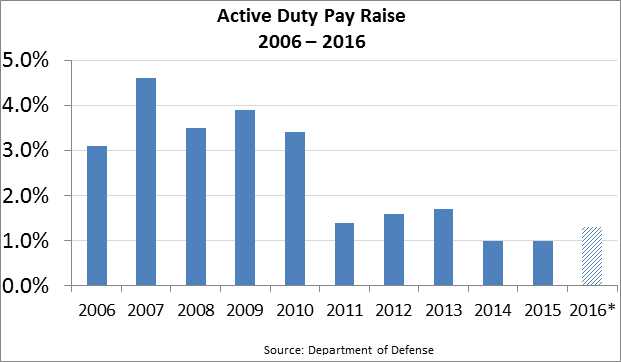February 6, 2015
On February 2, the administration unveiled its FY 2016 budget proposal. The record $4 trillion proposal includes a significant boost to the Pentagon’s baseline budget.
The proposed budget calls for the largest increase in acquisition spending in more than a decade and far exceeds sequestration’s budget cap of $499 billion. Despite these increases, the administration continues to call for cuts to military people programs to “slow the growth” of military personnel. The defense budget did not include any recommendations from the recent Military Compensation and Retirement Modernization Commission, which released its long awaited report on January 29.
The request is strikingly similar to the administration’s budget proposal last year and once again calls for a military pay cap, an increase in out-of-pocket housing costs, and higher TRICARE fees.

Specifics of the proposal include:
- Cap the FY 2016 active duty pay raise at 1.3 percent versus the 2.3 percent dictated by law. The proposal would amount to a third straight year of pay caps below private sector pay growth. The Pentagon is also requesting four additional years of caps (FYs 2017-2021)
- Reduce overall military end strength by 11,300
- Reduce the Basic Allowance for Housing (BAH). This would continue the effort to trim the benefit back by shifting 5 percent of costs onto servicemembers.
- Phase-in of $1 billion cut in the annual commissary subsidy that equates to a 66 percent loss of savings for commissary shoppers
- Establish a means-tested TRICARE For Life enrollment fee for retirees over 65
- Consolidate TRICARE Prime, Standard, and Extra programs into one program. Working age retirees would pay to use MTFs, and absorb the Prime enrollment fee plus the Standard copays.
Overall, the consolidation does not improve the health care benefit – it merely shifts more cost onto beneficiaries. Retirees will pay more for care without improved access, quality, or wait times.
MOAA’s initial analysis shows that the combination of the three years of pay caps, the full implementation of BAH and commissary cuts, and the TRICARE consolidation would significantly impact the loss of purchasing power for uniformed service families. An Army sergeant (E-5) with ten years of service and a family of four would lose over $5,000 a year in purchasing power. An Army captain (O-3) would lose more than $6,000.

The FY 2016 budget proposal regurgitates many of the cuts proposed last year. The Pentagon insists the cuts are necessary to trim spending on pay and benefits. The budget cites growing personnel costs that have “increased 85 percent” since 2001.
However, this fails to acknowledge that much of increased personnel spending since 2001 was requested by the service chiefs to restore compensation that had been slashed throughout the 1990s and resulted in severe retention problems.
The administration budget continues to target military personnel costs despite the fact that costs have steadily declined over the past five years. More importantly, the recent changes to pay and benefits have already started to bend the curve of personnel costs downward. Personnel growth has declined from its 2011 peak.

Source: DoD Green Book Table 6-11
If enacted, these cuts would represent four giant steps towards repeating the short-sighted cuts of the 1990s, which led to retention and readiness problems in the past.
MOAA is gearing up to remind Congress and the administration that military compensation and benefits are critical to sustaining a high-quality all-volunteer force.